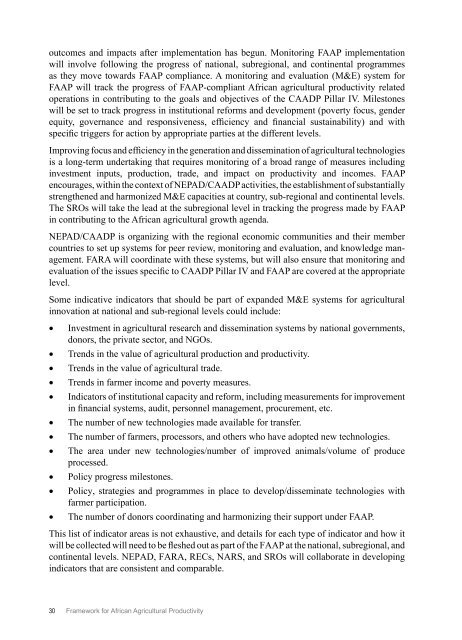Framework for African Agricultural Productivity (FAAP) - FARA
Framework for African Agricultural Productivity (FAAP) - FARA
Framework for African Agricultural Productivity (FAAP) - FARA
Create successful ePaper yourself
Turn your PDF publications into a flip-book with our unique Google optimized e-Paper software.
outcomes and impacts after implementation has begun. Monitoring <strong>FAAP</strong> implementationwill involve following the progress of national, subregional, and continental programmesas they move towards <strong>FAAP</strong> compliance. A monitoring and evaluation (M&E) system <strong>for</strong><strong>FAAP</strong> will track the progress of <strong>FAAP</strong>-compliant <strong>African</strong> agricultural productivity relatedoperations in contributing to the goals and objectives of the CAADP Pillar IV. Milestoneswill be set to track progress in institutional re<strong>for</strong>ms and development (poverty focus, genderequity, governance and responsiveness, efficiency and financial sustainability) and withspecific triggers <strong>for</strong> action by appropriate parties at the different levels.Improving focus and efficiency in the generation and dissemination of agricultural technologiesis a long-term undertaking that requires monitoring of a broad range of measures includinginvestment inputs, production, trade, and impact on productivity and incomes. <strong>FAAP</strong>encourages, within the context of NEPAD/CAADP activities, the establishment of substantiallystrengthened and harmonized M&E capacities at country, sub-regional and continental levels.The SROs will take the lead at the subregional level in tracking the progress made by <strong>FAAP</strong>in contributing to the <strong>African</strong> agricultural growth agenda.NEPAD/CAADP is organizing with the regional economic communities and their membercountries to set up systems <strong>for</strong> peer review, monitoring and evaluation, and knowledge management.<strong>FARA</strong> will coordinate with these systems, but will also ensure that monitoring andevaluation of the issues specific to CAADP Pillar IV and <strong>FAAP</strong> are covered at the appropriatelevel.Some indicative indicators that should be part of expanded M&E systems <strong>for</strong> agriculturalinnovation at national and sub-regional levels could include:• Investment in agricultural research and dissemination systems by national governments,donors, the private sector, and NGOs.• Trends in the value of agricultural production and productivity.• Trends in the value of agricultural trade.• Trends in farmer income and poverty measures.• Indicators of institutional capacity and re<strong>for</strong>m, including measurements <strong>for</strong> improvementin financial systems, audit, personnel management, procurement, etc.• The number of new technologies made available <strong>for</strong> transfer.• The number of farmers, processors, and others who have adopted new technologies.• The area under new technologies/number of improved animals/volume of produceprocessed.• Policy progress milestones.• Policy, strategies and programmes in place to develop/disseminate technologies withfarmer participation.• The number of donors coordinating and harmonizing their support under <strong>FAAP</strong>.This list of indicator areas is not exhaustive, and details <strong>for</strong> each type of indicator and how itwill be collected will need to be fleshed out as part of the <strong>FAAP</strong> at the national, subregional, andcontinental levels. NEPAD, <strong>FARA</strong>, RECs, NARS, and SROs will collaborate in developingindicators that are consistent and comparable.30<strong>Framework</strong> <strong>for</strong> <strong>African</strong> <strong>Agricultural</strong> <strong>Productivity</strong>
















